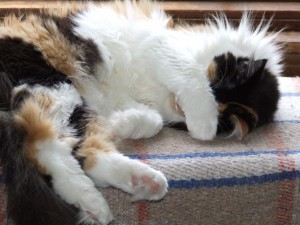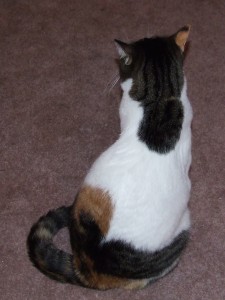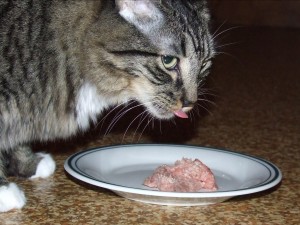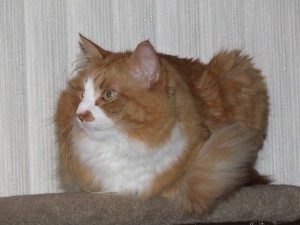Written by Tracy Dion and originally published in Raw Instincts Magazine, June 2012.
Many cat owners, already deeply sensitized to the potential risks of raw-feeding, panic when they run into a problem during the transition period. This is unfortunate, as the large majority of these problems are easy to address and not a reason for alarm. 
The same issues can occur whether you start with canned or kibble and switch to ground, prey model or whole prey raw foods, and a little patience and some detective work are all that’s usually needed to identify and address the root cause.
Preventive strategies are always a good idea, and starting your cat on a healthy probiotic – one with 10 or more live strains of bacteria – a week or two in advance of the transition will help strengthen her digestive system and reduce the likelihood of digestive upsets. Taking the transition slowly and introducing one product at a time will further lower those chances.
Despite our best efforts, however, problems may still pop up. Here are the most commonly experienced issues, their potential causes and the most likely solutions.
Problem: Won’t even try the new food.
Solution: Many times, cats raised on a life-time of canned mush or crunchy, coated kibble bits don’t recognize raw foods as foods. The smell, taste and texture are very different, and feline instincts are naturally wary of eating anything unfamiliar.
Thankfully, cats can be “re-programed”. Take a small dollop or chunk of the raw food you want your cat to start eating and place it next to her regular food at every meal. This will accustom her to the scent and sight of the raw food and help her begin to associate it with meals. Persistence will be your key and patience your greatest ally, as it can take a few days to over a month before she is willing to accept the raw as food.
Problem: Likes it; then doesn’t.
Solution: Feline instinct also encourages cats to eat a variety of their familiar foods, and if fed the same product day after day, they may lose their taste for it. This is sometimes referred to as “the monotony effect.” To prevent this, rotate through as many different animal meats as you can source.
Regular rotation of a variety of meats will also provide a stronger nutritional profile. A meta-study completed in 2008 concluded that our cats’ bigger cousins, like the lion and the leopard, need between five and seven different prey types to meet their nutritional needs; although it is believed by most that a minimum of three or four is sufficient for house-cats, the more variety, the better.
Problem: Throwing up.
NOTE: Throwing up is a cat’s natural response to a huge range of issues, from the simple to the life-threatening. If your cat can’t keep anything down, hasn’t eaten in over 48 hours or seems lethargic and/or feverish, veterinarian attention is recommended.
Solution: Throwing up within an hour or so after eating is referred to as regurgitation. Even limiting ourselves to discussing regurgitation-related vomiting only, there are many potential causes; in no instance, however, should recurrent regurgitation be considered normal. There is always a reason and it should be addressed to prevent further complications for the cat.
Cats are instinctively inclined to prefer warm foods and will sometimes regurgitate meals that are too cold, so ensure any food you offer is close to room temperature by taking the packaged food out of the fridge fifteen or so minutes early, or placing it in a bowl of warm (not hot) water for a few minutes.
Eating too fast, eating too much, and swallowing pieces that are too large all cause regurgitation. They are also related to going too long between meals, as happens frequently with cats that are fed only twice a day. Going too long without food can also create a build-up of stomach acid that will make the cat uncomfortable and nauseous, and can cause vomiting of yellow bile and white foam before a meal as well as regurgitation of a recently-eaten meal.
According to the National Research Council, cats would naturally eat between twelve to twenty meals in a twenty-four hour period. Dropping them down to three or four meals a day is a drastic reduction, but is tolerated more easily than only two. Feeding the first meal within a half-hour of rising (but NOT immediately after you get up, unless you want your cats to start waking you to be fed), right after you get home in the evening and again just before you go to bed works very well for most cats.
If your cat is still prone to hunger vomiting, giving her something small to nibble on while you’re preparing her food will absorb some of the acid and make her more comfortable and less likely to get sick. Freeze-dried meat treats work really well for this.

Competition can also cause cats to eat too fast or swallow unacceptably large bites. Giving each cat her own plate, placing them further apart or feeding them on different levels, and ensuring they eat in uninterrupted quiet should alleviate their anxiety and help them slow down. Crating is also very helpful. With some cats, however, it may be necessary to feed them in separate rooms.
Cats new to prey model or whole prey foods are inexperienced and may bite off a larger piece than they can properly digest. The cat may make strange noises trying to swallow the food, and it will often come right back up to be re-chewed and swallowed again. Until the cat gains the necessary experience, cut her food down a bit before offering it to her.
In all of the above cases, it’s perfectly acceptable to let the cat re-eat the food. If she doesn’t do it on her own, you can sprinkle it with something enticing to encourage her. (This is easy to do when cats are crated for meals.)
If the cat is constipated or has a hairball problem, a full stomach will be uncomfortable and might result in regurgitation. Careful observance of litter box habits will help you recognize incipient constipation, and regular brushing will help prevent hairball issues. Neither of these issues occurs very often once a cat has been fully transitioned to a properly balanced raw diet.
If you’re feeding a prey model raw diet and none of the above problems seem likely, check to ensure the meats and organs you’ve purchased are not enhanced. The sodium content should be no more than 100 mg or so per serving.
Problem: Constipation / Diarrhea.
Solution: Constipation is generally caused by too much bone in the diet. If you are feeding a commercial blend, call the manufacture for the product’s bone to meat ratio; anything over 7% is high and should be diluted by adding fresh meat. If you are feeding a prey model raw diet using the 80/10/5/5 guideline, reduce the amount of bone in your bone-in meals from 10% to 7% (cats don’t require the same amount of bone as do their canine counterparts). If necessary, you can drop that even further to 5%.
Diarrhea is encountered more often than constipation during raw-feeding transitions and can be a little more difficult to address. The spices in enhanced meats can cause loose stools, as can quality control issues in commercial ground mixes; the former you have control over, the later you don’t. If you suspect an issue with a commercial raw food, switch to something else for a while.
Prey model raw feeders may be feeding too much fat, too many organ meats or too little bone – or some combination thereof. Double-check your numbers to ensure you’re within the 83/7/5/50 guidelines, then tweak your cat’s diet by adding a bit more bone, removing skin and other fat sources, or cutting back on organ meats.
Taking the transition too fast can also cause diarrhea. Add new products one at a time, even mixing them with current products if your cat seems to be particularly sensitive to changes in her diet. Be especially careful with organ meats; feed them in pea-sized amounts to begin with until you know your cat can handle them, and never feed a full meal of organs.
Cats that have a history of digestive issues such as IBS and IBD need significantly slower transitions to allow their irritated and inflamed digestive systems plenty of time to adjust to eating their natural diet.
Conclusion
Providing your beloved kitty with the foods she is naturally designed to eat is probably the single most important choice you will ever make for her, but it isn’t always a smooth transition. Preparing in advance, taking it slow, and being both patient and persistent will help ensure the best transition possible, and will pay off huge dividends in the long-term health of your cat.
If you enjoyed this article or found it informative, please “Like” it, “Tweet” it, or share it using any of the buttons below. And don’t forget to check out our FB page, join the discussions in our awesome FB group and follow us on Twitter!
Created 07/15/12; Updated 09/18/17

